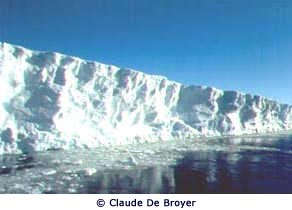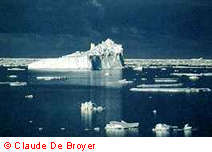|
|
|
|
Icebergs and ice shelves The ice shelves The ice shelf or platform of floating ice can be compared to an enormous slab of ice which, attached to the glacier that produced it, is poured out by it on to the ocean. We are not talking here of marine ice but of terrestrial ice that has recently seeped on to the surface of the ocean. It is the thousand-year traverse of the glaciers and their incredible thickness that have been able to produce throughout the centuries such coulees. The ice shelves are interesting under more than one heading. Currently, with the help of radio echo soundings, it is in effect possible to determine with precision the place where the ice shelf detaches itself from the bed rock; these are areas that are thought to be dangerous because of the hinge effect that the ice undergoes there and because of the numerous crevasses that are produced there. A further phenomenon that has awoken the interest of scientists: they have observed, in effect, that the water coming from the formation of the ice floe close to the continent - dense water because of its strong salinity (rejection of salt when the ice is formed) accomplishes an underwater journey underneath the ice shelf in the direction of the anchorage point. Because they are brought by stronger pressure, this water finds itself above its freezing point and as a result has sufficient calories to melt a certain quantity of the ice located at the base of the ice shelf. Which creates melted water that is naturally less dense (the ice of the ice shelf is terrestrial ice and therefore not saline) which finds its way beneath the ice shelf; because its pressure reduces, it is brought down to below its freezing point and forms ice deposits (known as frazil ice or marine ice) which come to attach themselves under the ice shelf, thereby thickening it and in consequence strengthening it. Jean-Louis Tison, a Belgian geographical physicist from Brussels University, whose career has been redirected towards the chemistry of the ice, describes the importance of this phenomenon: "The katabatic winds", he explains, "are capable with their incredible violence of strongly eroding the surface ice of the ice shelf and thus causing a progressive disappearance of the continental ice in favour of a contribution of ice coming from Be that as it may, the spectacle offered by the ice shelves when they are at they end of their journey is often grandiose: a vertical cliff that falls precipitously on to the ocean. The largest ice shelf in the Antarctic is the Ross Ice Shelf. With a surface area of 540,000 km², it contains a third of all the floating ice in the Antarctic and is 90 metres thick at its hinge point and 200 metres at the front. That is where fractures are produced; that is what creates icebergs. Unlike the ice shelf, which is a form of ice with which the public at large is unfamiliar, the iceberg is part of the polar saga. Since the furthest time, these enormous blocks of ice have in effect provoked catastrophes and terrified navigators. The latter have often recounted how, when the visibility at the 40th parallels prevented the icebergs from being seen from afar, they would consult the thermometer in order to detect the slightest variation in temperature: a sudden fall of one or two degrees could mean, in effect, that they were in the immediate vicinity - two or three kilometres at the most - of an iceberg. There are several thousand icebergs around the Antarctic: in 1985, a scientific expedition counted at least 30,000 in an area of 4,000 km², between 40° and 168° longitude east, and it is estimated that about 1,500m³ of ice comes away from the ice shelves each year in the form of icebergs. Their size goes naturally from the lump of ice that suddenly falls from the cliff to a gigantic block that takes years to detach itself from the glacier to which it belongs. On 12 November 1956, the American vessel Glacier signalled the presence of one of the biggest icebergs that had ever been seen: it measured 335 kilometres long and 97km wide, or the size of Belgium, and, in view of its size and shape, would have contained at least 31,000k³ of ice.
|

 beneath the platform. The greater the quantity of marine ice that forms beneath the ice shelf, the more the platform is stabilised on the water and more the seeping coming from the ice cap is inhibited by this process. Which implies on the one hand that the splitting off of icebergs is also inhibited, and on the other that the participation of the ice cap in the raising of the seal level is restricted. If, on the contrary, the share of the melting linked to the warming of the ocean increases, the thickness of the ice shelves diminishes and, instead of being reinforced, these platforms are made weaker; which engenders a faster seeping towards the ocean and a more significant draining of the ice from the ice cap. This mechanism could, in the long run, destabilise a large part of the Antarctic ice cap and have unimaginable consequences in terms of raising sea levels."
beneath the platform. The greater the quantity of marine ice that forms beneath the ice shelf, the more the platform is stabilised on the water and more the seeping coming from the ice cap is inhibited by this process. Which implies on the one hand that the splitting off of icebergs is also inhibited, and on the other that the participation of the ice cap in the raising of the seal level is restricted. If, on the contrary, the share of the melting linked to the warming of the ocean increases, the thickness of the ice shelves diminishes and, instead of being reinforced, these platforms are made weaker; which engenders a faster seeping towards the ocean and a more significant draining of the ice from the ice cap. This mechanism could, in the long run, destabilise a large part of the Antarctic ice cap and have unimaginable consequences in terms of raising sea levels." 